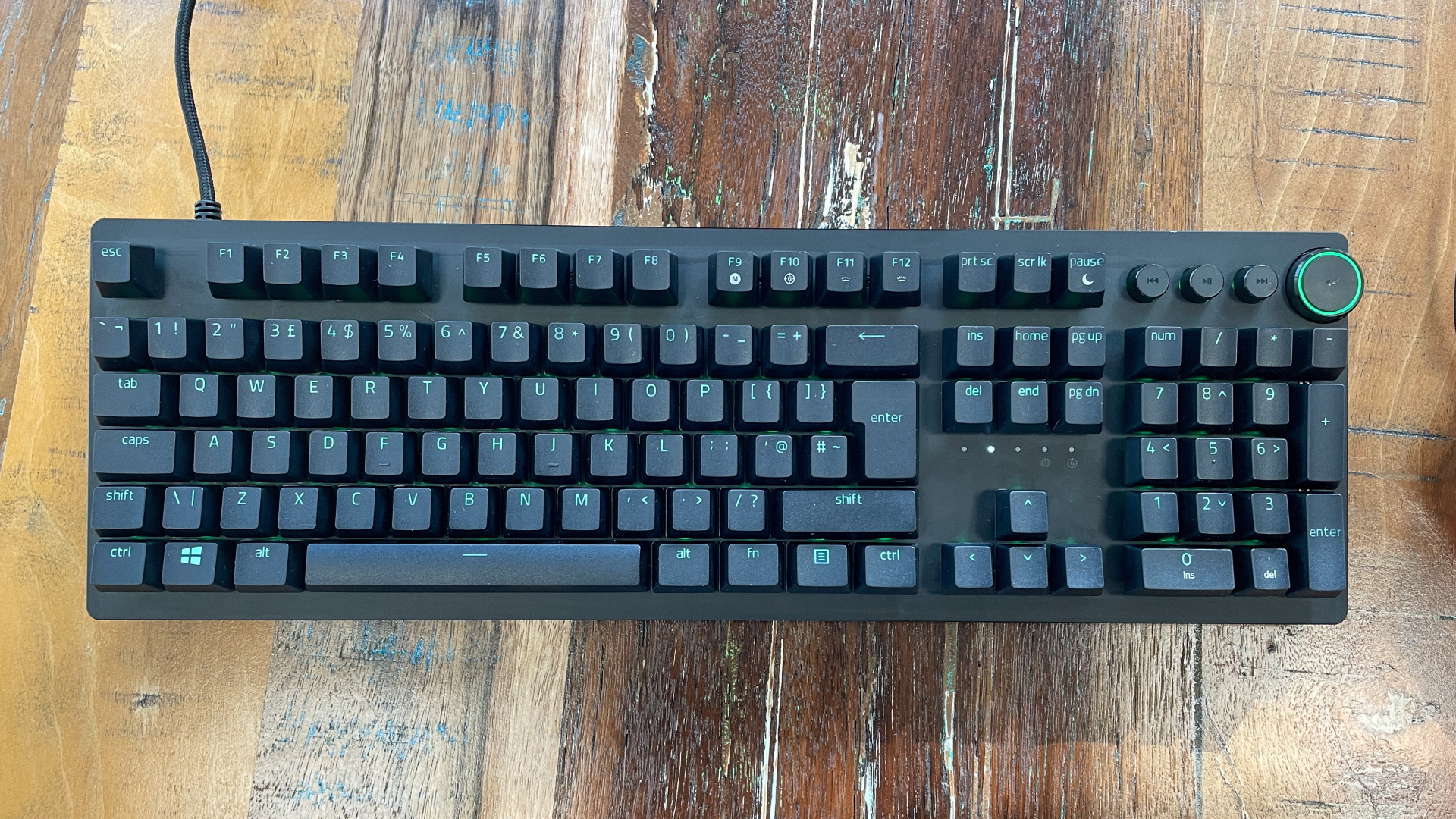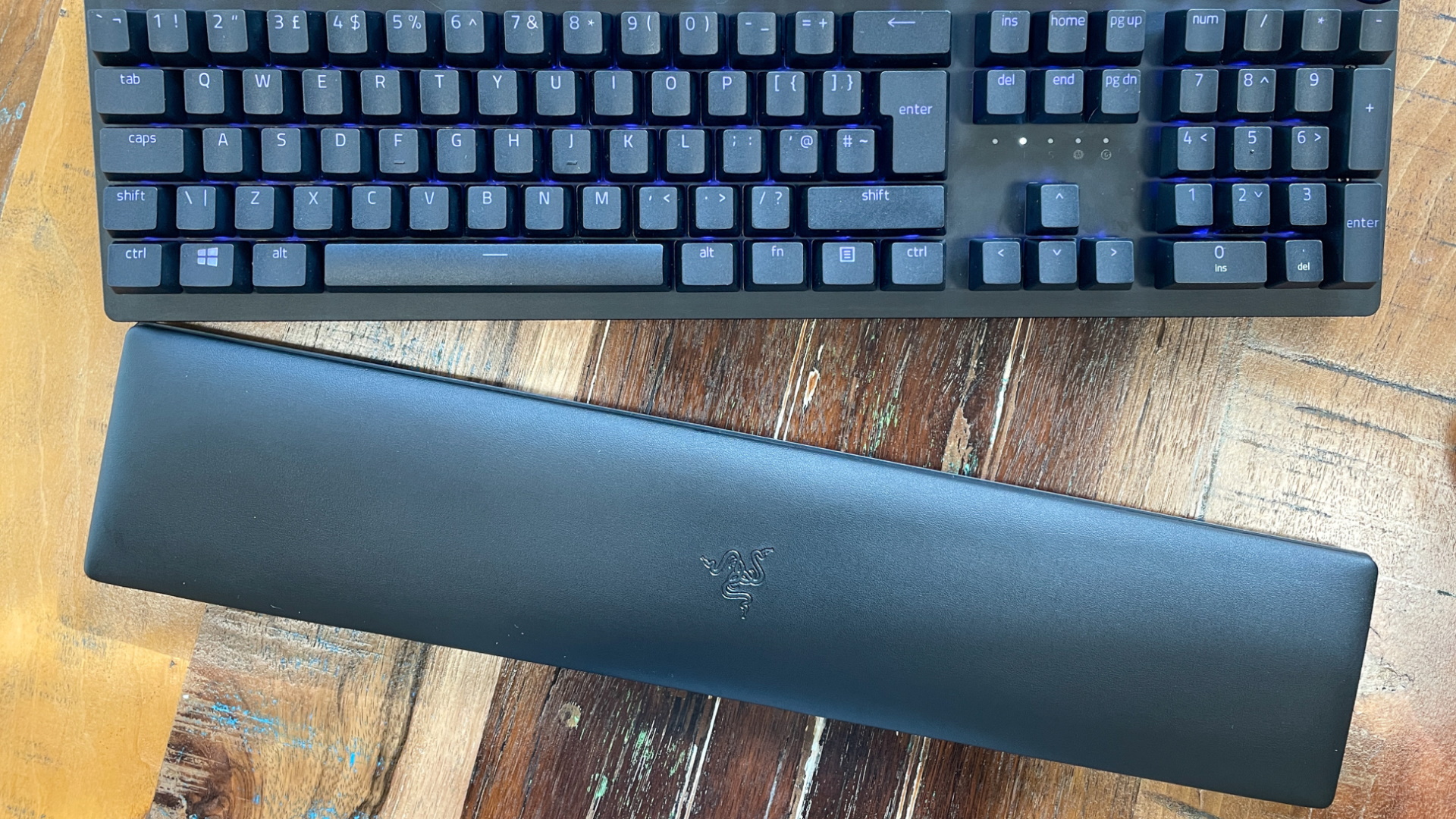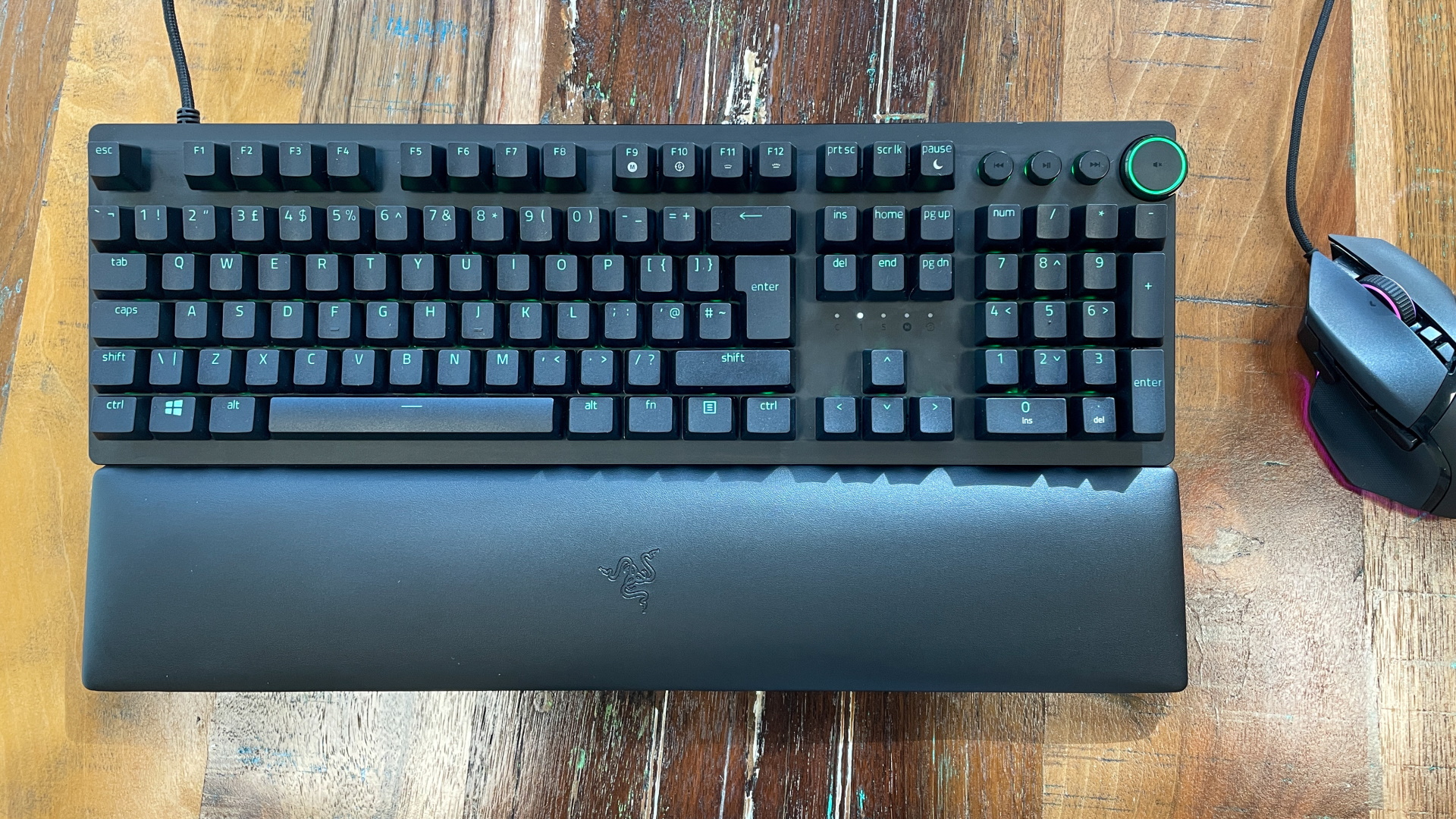GamesRadar+ Verdict
The Razer Huntsman V2 takes things back to basics, with fewer fancy RGB effects and no USB-passthrough. However, it remains a master class in speed and responsiveness.
Pros
- +
Super fast and lightweight key presses
- +
Multi-function media dial
- +
Excellent wrist rest
Cons
- -
8K hyperpolling might not be necessary for everyone
- -
Key presses twang after bottoming out on Clicky model
Why you can trust GamesRadar+
Razer has, once again, refreshed its flagship lineup of Huntsman gaming keyboards with the Razer Huntsman V2. However, this new edition marks a stark return to the principles behind these speedy decks after a few releases that ventured into new waters. As an example, the Razer Huntsman V2 Analog brought incredible variable actuation points to its optical switches, while the Elite has been glowing on the shelves for a few years now. The V2 strips all that away.
The Razer Huntsman V2, with all its 8K hyper polling and optical switches, doesn't seek to replace either of these variants. Instead, it takes things back to basics - the latest premium deck drops some of the additional features of the Huntsman Elite and Analog to focus purely on speed.
The result is a $199 ($189 for a linear switch) deck looking to use its zero latency design to wrestle with some of the best gaming keyboards on the market.
Design
The Razer Huntsman V2 looks very similar to both the Analog and Elite at first sight. You're getting the same broad design that many have come to rely on for a wealth of macro options in that full set of keys. Nevertheless, a closer look reveals some key differences in the latest model.
You're getting a slightly thinner frame here, likely due to the removal of the RGB underglow and circling that was found on the Elite and Analog models. This has been replaced by simple RGB legends on the top of each doubleshot PBT keycap and circles of bright light around each of the dedicated media keys. While it's certainly a simpler design, those who were looking to pair the underglow effect of the Elite with the similarly lit Razer Basilisk V3 will be a little disappointed here.

However, if you're one for comfort, the included wrist rest could certainly lift your spirits. This is an exceedingly comfortable option, far softer than the free models often included with the best Razer keyboards. The cushioning has a perfect density, so that rather than sitting my hands on top of the padding, it felt like my wrists were being moulded into the material much like memory foam. It helps that there's an edge-to-edge design here, as per the Analog, which means no awkward plastic lip to bezel the experience.
The Razer Huntsman V2, overall, speaks a subtle design language. There's no outlandish RGB here, and a solid black aluminium and plastic chassis keep things simple. The legends are also clear and brightly lit, though it's worth noting that longer text on keys like print screen and pause is subject to a little warping which feels a little cheap on such a premium deck.
Features

Price: $199.99 / £199.99
Form factor: Full
Switches: Razer Optical
Keycaps: Doubleshot PBT
Media keys: Dedicated buttons and dial
Wrist-rest: Ergonomic pleather
USB passthrough: None
Connectivity: Wired
Interestingly, the biggest feature of the Razer Huntsman V2 isn't exactly the star of the show here. This is the first Razer keyboard to feature 8k hyperpolling, a feature that allows your deck to communicate with your PC at 8x the rate of a standard set of keys. That makes it a good companion for the Razer Viper 8K Hz mouse, which pulled off the same feat.
That's impressive on paper, but I rarely found a use for such speed, especially playing everyday action and fps titles. Even when the mode was switched on, it was difficult to notice much of a difference. The whole keyboard does feel faster than previous releases, but I'm not convinced the hyperpolling is the cause here.
Instead, the optical switches are where you'll notice the power of this particular device. By using a purely light-based system, the Razer Huntsman V2 bypasses the 'debounce' problem with mechanical switches.
Mechanical switches apply a filtering technique to ignore accidental connections between the contacts within the switch. This filter stops chattering or accidental pushes, but can add milliseconds of input lag to each press. By using optical switches, the Huntsman V2 can offer a super low latency connection that still offers the tactile bump in my clicky purple switch review unit.
You're still keeping the multi-function dial of the previous releases, outfitted with a clicky and responsive feel and compatibility with a range of software including Premiere Pro. Plus, there's three dedicated media keys with very short, stiff clicks to them lined up along the top right.
Performance
The optical switches inside the Razer Huntsman V2 make for a super responsive experience, and one that feels far speedier than other Razer models. Razer, however, has taken the feel of these keys one step further, for worse or better.
Adding a sheet of sound dampening foam to your mechanical keyboard is a well known trick for achieving a deeper, quieter sound when bottoming out your switch. This has been applied to the new Huntsman, but there's a caveat when it comes to the purple Clicky variant. There is a deeper sound when each key is fully actuated, but by absorbing some of the switch's clicky sounds, Razer has left us wide open to stabilizer twang.

The keys certainly have a soft landing to them, but the reverb from those switches quickly became frustrating, especially when using the keyboard as an everyday work device.
In fact, while the speed and lightness of these keys makes for a lightning fast in-game experience, typing feels a little sloppy. It takes a little getting used to, learning to press lighter on the keys to use the Huntsman V2 in the way it was intended, but it's definitely a learning curve.
However, getting our hands on the linear red switches immediately solved the problem. We were treated to a soft press with an incredibly low amount of extra sound. There isn't the deep mechanical keyboard thock here, but a satisfying dampening that makes each tap whisper quiet.
The sensitivity in both models, combined with the textured keycaps, is perfect for reflex movements in-game. While you won't quite get away with a featherlight tap, a nudge is more than enough to glide across the keys in intense situations.
Should you buy the Razer Huntsman V2?

The Razer Huntsman V2 is obviously a super fast device, but the extreme end of that speed may not be necessary for (or even noticed by) the everyday player. 8K hyperpolling didn't make much of a difference to the experience in my testing, but the optical switches packed in here certainly did.
This is a super responsive keyboard, and once you get those lightweight key presses down you'll be flying across the deck with incredible speed and precision. However, if you do share a space, be warned that that sound dampening foam has some twanging sound effects in the purple Clicky switches that aren't for the easily irritated.
We're also rounding up all the best gaming mouse options out there, as well as the top Razer mouse models on the market right now. Or, if you're after a full refit, take a look at the best gaming monitors available.

Managing Editor of Hardware at GamesRadar+, I originally landed in hardware at our sister site TechRadar before moving over to GamesRadar. In between, I've written for Tom’s Guide, Wireframe, The Indie Game Website and That Video Game Blog, covering everything from the PS5 launch to the Apple Pencil. Now, i'm focused on Nintendo Switch, gaming laptops (and the keyboards, headsets and mice that come with them), PS5, and trying to find the perfect projector.



